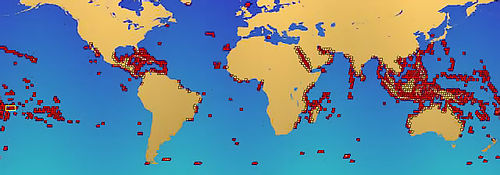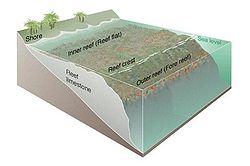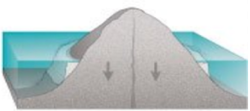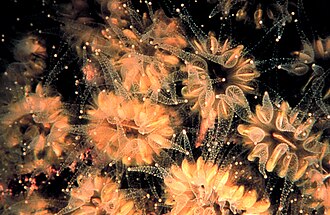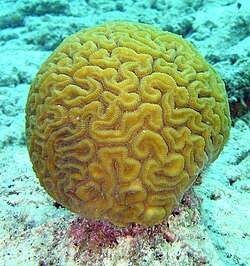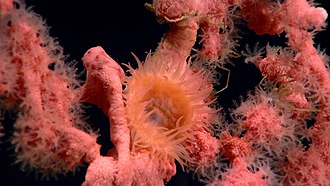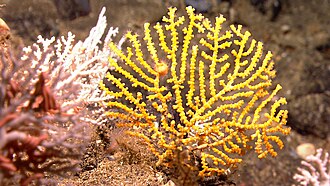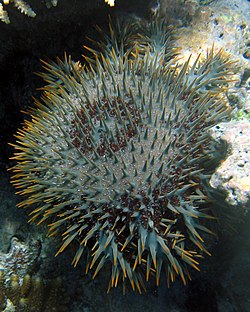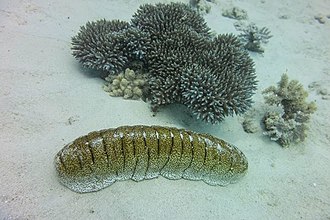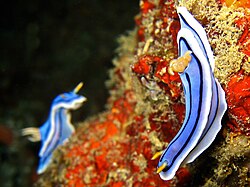Difference between revisions of "AY Honors/Coral Reefs"
Jomegat bot (talk | contribs) (Bot: Automated import of articles) |
|||
| Line 9: | Line 9: | ||
|authority=North American Division | |authority=North American Division | ||
|insignia=Coral Reefs AY Honor.png | |insignia=Coral Reefs AY Honor.png | ||
| + | |field_trip=optional | ||
}} | }} | ||
</translate> | </translate> | ||
| Line 20: | Line 21: | ||
The most challenging requirement of this honor is probably this: | The most challenging requirement of this honor is probably this: | ||
| − | <b>{{reqreq|page={{PAGENAME}}|num= | + | <b>{{reqreq|page={{PAGENAME}}|num=14}}</b> |
| + | :<b>{{reqreq|page={{PAGENAME}}|num=14a|dispreq=a.}}</b> | ||
| + | :<b>{{reqreq|page={{PAGENAME}}|num=14b|dispreq=b.}}</b> | ||
| + | :<b>{{reqreq|page={{PAGENAME}}|num=14c|dispreq=c.}}</b> | ||
| + | :<b>{{reqreq|page={{PAGENAME}}|num=14d|dispreq=d.}}</b> | ||
| + | :<b>{{reqreq|page={{PAGENAME}}|num=14e|dispreq=e.}}</b> | ||
| + | :<b>{{reqreq|page={{PAGENAME}}|num=14f|dispreq=f.}}</b> | ||
| + | :<b>{{reqreq|page={{PAGENAME}}|num=14g|dispreq=g.}}</b> | ||
</translate> | </translate> | ||
Revision as of 21:42, 25 December 2020
Overview
The Challenging Part
The most challenging requirement of this honor is probably this:
14. Do at least two of the following:
- a. Visit an aquarium which exhibits reef species.
- b. Make a collection of at least five species of dead coral you find washed up on a beach or fossil corals. Make sure you obey local laws about collecting.
- c. Watch a presentation about reefs. Summarize what you learned about coral reefs.
- d. Draw or paint a picture of a reef community with at least ten species.
- e. As a group, make a short video about a reef conservation project. Explain why this specific habitat should be saved.
- f. Create a 3D diorama of a coral community.
- g. A similar project approved by your instructor.
[[AY Honors/Coral Reefs/Requirements|Tab Name/Printable Version]]
1. What is a reef? Identify two types of "building blocks" of reefs.
2. Answer the following:
- a. Is coral a plant or animal?
- b. In what phylum is coral categorized?
- c. What part of a coral reef is living?
- d. Distinguish between soft and hard corals.
3. Where are coral reefs found? Describe the conditions that are needed for healthy coral growth.
4. Describe and/or draw a diagram showing at least three different types of coral reefs.
- a. Fringing Reefs
- b. Barrier Reefs
- c. Atolls
- d. Patch Reef
5. Define zooxanthellae.
6. Answer the following questions about how corals get their food:
- a. Which type of feeding primarily occurs at night and why does this result in clear water?
- b. Which type of feeding occurs primarily during daylight hours
- c. Why are coral reefs found in clear water?
7. Identify five corals that can be found on a reef.
8. Identify ten fish that live in a coral reef.
9. Identify five species of non-coral invertebrates that might live on a reef.
10. Define "bleaching" as it pertains to corals, and explore the impact this has on the reef.
11. Identify at least one invasive species and how it affects reefs.
12. Why are reefs an important community? List at least three ways that you can help protect a reef.
13. Prepare an object lesson about an animal that lives in the reef. Present this lesson at a club worship or similar function. Be sure to include a Bible text in this presentation.
14. Do at least two of the following:
- a. Visit an aquarium which exhibits reef species.
- b. Make a collection of at least five species of dead coral you find washed up on a beach or fossil corals. Make sure you obey local laws about collecting.
- c. Watch a presentation about reefs. Summarize what you learned about coral reefs.
- d. Draw or paint a picture of a reef community with at least ten species.
- e. As a group, make a short video about a reef conservation project. Explain why this specific habitat should be saved.
- f. Create a 3D diorama of a coral community.
- g. A similar project approved by your instructor.
Printable Answer Key Tab Name/Edit Answer Key
1
Reefs form in sea water and are a build-up of the remains of the hard parts of animals – mostly calcium carbonate. Some reefs can be over 30 m thick. Some reefs are formed from layers of oysters (or other species of mollusk) growing on top of each other – called oyster reefs. Some reefs are composed of layers of coral skeletons growing on top of each other – called coral reefs.
2
2a
Corals are animals.
2b
Corals are in the phylum Cnidaria (the C is silent - nigh dare ia). Some forms of Cnidaria are mobile and swim around like jellyfish, other types are sessile which means they are anchored to the substrate and do not move around. These are the corals that build coral reefs.
2c
Only the top layer of a reef is alive. As we will learn later, corals require sunlight to live so only those on top can survive.
2d
Hard corals are soft-bodied animals which secrete a hard calcium carbonate layer around them and have multiples of 8 tentacles used in feeding. These are the reef builders. Soft corals are soft bodied animals which secrete very little calcium carbonate so they are not hard, but can sway back and forth in the ocean currents. Soft corals have multiples 6 tentacles used in feeding.
3
Coral reefs are found between 30 degrees north and south of the equator.
They require:
- Warm water
- Shallow water (so that there is enough sunlight),
- Saltwater
4
4a
Fringing Reefs: grow near the shoreline of continents and islands and are usually separated from the land by a shallow body of water called a lagoon.
4b
Barrier Reefs: similar to fringing reefs but are further away from shore often grow along the edge of the continental shelf. If they grow to the surface, ships cannot get through to the mainland and thus are called "barriers". The resulting lagoons are deeper and larger than in fringing reefs.
4c
Atolls: a fringe reef that grows around a small island but then the island erodes away or sinks which leaves a ring of reef surrounding a lagoon.
4d
Patch Reef: an isolated patch of reef that grows up from the floor of the lagoon of a barrier reef. They seldom reach the surface of the water.
5
Zooxanthellae are microscopic algae that live inside soft parts of corals. The different species of zooxanthellae give the corals their color (otherwise they would look white – the color of calcium carbonate). The calcium carbonate shell of the coral protects the delicate algae. The coral benefits by eating some of the sugar that the algae make using energy from the sun. This is a great example of symbiosis – both the coral and the algae benefit by living together.
6
6a
At night, the corals extend their soft tentacles out into the water to trap and collect food that is floating in the water. They use nematocytes which are microscopic harpoons loaded with venom to catch and stun their prey before eating it.
6b
Corals grow a garden of algae and eat sugars and other molecules produced by the garden of algae growing in their body (the zooxanthella). This is why corals can only grow in shallow water where there is enough sunlight for the zooxanthella to grow and do photosynthesis. It is also why only the top layer of a coral reef is alive. If another coral grows over top, the one below will die because its zooxanthella will not get any light and there won’t be food for the coral on the bottom.
6c
By filtering all the food particles out of the water (a above), the seawater around a reef is very clear.
7
8
25% of the animals in oceans are found in reefs, although reefs account for only about 1% of the ocean surface area.
9
stars, jellyfish, anemones, sand dollars, sea cucumbers, and many more.
10
When conditions change (temperature, pH, light levels salinity, etc.) the corals dump out their colorful zooxanthella and become white (the color of their calcium carbonate shells); then they take in new zooxanthella with different characteristics that might thrive better than the previous zooxanthella. It’s just a "gamble" to try to survive better with a different genetic combination. For some corals, the gamble is lost and they die. For other’s the new Zooxanthella do make a difference and the remaining coral takes over the reef building on top of the old coral. Climate change is resulting in increased temperature in the coral reef areas and is causing a lot of bleaching. Too much bleaching can cause the reef to die because it simply can’t keep up.
11
Lionfish have venomous spines and frilly fins. They are native to the Indian and Pacific Oceans. They were dumped into the Atlantic Ocean by pet owners that did not want to keep them anymore. They thrive in the coral reefs in the Atlantic where they eat many fish and invertebrates that are a crucial part of the reef ecosystem. They have no natural enemies so they continue to outgrow the reefs.
Nudibranches eat the corals. Hawaii is experiencing a huge invasion by Nudibranches, many of which were once pets in tropical aquariums.
12
Corals are one of the most biologically diverse biomes in the world and one of the most productive. Young fish from the ocean hide in the corals to avoid their enemies until they are large enough to survive on their own. The coral reefs help protect the inner shorelines from erosion by large waves from the ocean. Coral caused shipwrecks of explores and merchant ships offshore, but now provide tourism and recreation which help the local economies. It’s always a good thing when we learn about and care for God’s creation – that’s a job we were all given to do in the Garden of Eden and it still applies to us today.
- Don’t pollute – silt covers the coral and they can’t get enough sunlight
- Don’t collect live coral
- Don’t touch live coral – you damage the soft tentacles and they can’t feed at night.
13
There are many topics that lend to an excellent object lesson. Let your imagination run!
14
14a
14b
14c
14d
14e
14f
14g
References
Content on this wiki is generated by people like you, and no one has created a lesson plan for this honor yet. You could do that and make the world a better place.
See AY Honors/Model Lesson Plan if you need ideas for creating one.
